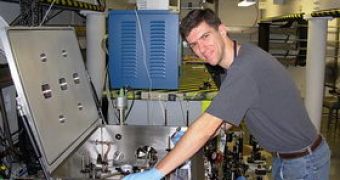There has been a concerted effort to find alternate mechanisms that can provide higher accelerating gradient. These involve acceleration by fields induced in plasmas and acceleration by focused short laser pulses.
Physicist Chris Sears and his team at the Next Linear Collider Test Accelerator (NLCTA) are replacing microwave power from klystrons with laser-generated visible light to boost the energy of particles. The laser could give particles up to 30 times more energy per meter than they gain from microwave power in the SLAC linac.
What's more, the researchers aspire to revolutionize accelerator design by one day placing major components - the laser and the accelerator structures in which particles travel - on mass-produced silicon chips. This accelerator-on-a-chip idea would allow for shorter and cheaper accelerators.
Lined up, tens of thousands of these chips could potentially accelerate a particle beam on its way to a conventionally sized detector.
Laser-powered acceleration of charged particles promises extraordinary acceleration gradients due to the immense power available from lasers. This possibility has led to many proposed structures for laser acceleration; however, the field of vacuum laser acceleration is almost wholly unexplored experimentally. Recent advances in laser efficiency and phase synchronization have made possible a practical laser accelerator and are a strong motivation for this experiment.
Earlier experiments on campus showed that acceleration with visible light is possible using very simple accelerator structures. These experiments also met the difficult challenge of making micron-sized laser and electron beams and of synchronizing them with each other within a trillionth of a second. Unfortunately, these structures used the laser power inefficiently.
For now, researchers have set up a full-sized laser whose beam is focused down to fit through the prototype accelerator structure - a tiny photonic crystal fiber, similar to telecommunications optical fibers, ordered from a catalog that Colby describes as the K-Mart of optics. Electrons and light pulses will travel through a hole in the photonic crystal that is 10,000 times narrower than the accelerator structures at SLAC.
The laser both generates electrons - which are first accelerated in the NLCTA - and also pushes the electrons once they reach the experimental chamber, which is slightly bigger than a cooler. A miniature undulator and chicane - types of magnets that wiggle and bend electron bunches to break them into smaller pulses - make the electrons short enough to catch a ride on each laser pulse, which only lasts one trillionth of a second.
"This is a distant dream, it's not something we even know how to do in 10 years," said experiment spokesman Eric Colby, about the possible future applications. "But companies already know how to deposit microscopic lasers on silicon, and they can write optics and mirrors onto chips, too. A microscopic accelerator structure could be printed out of the silicon itself."

 14 DAY TRIAL //
14 DAY TRIAL //